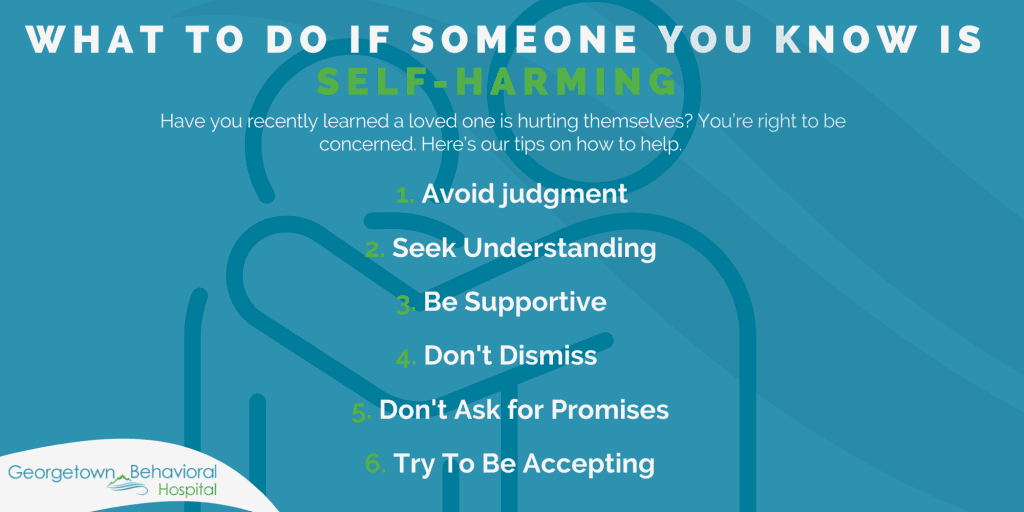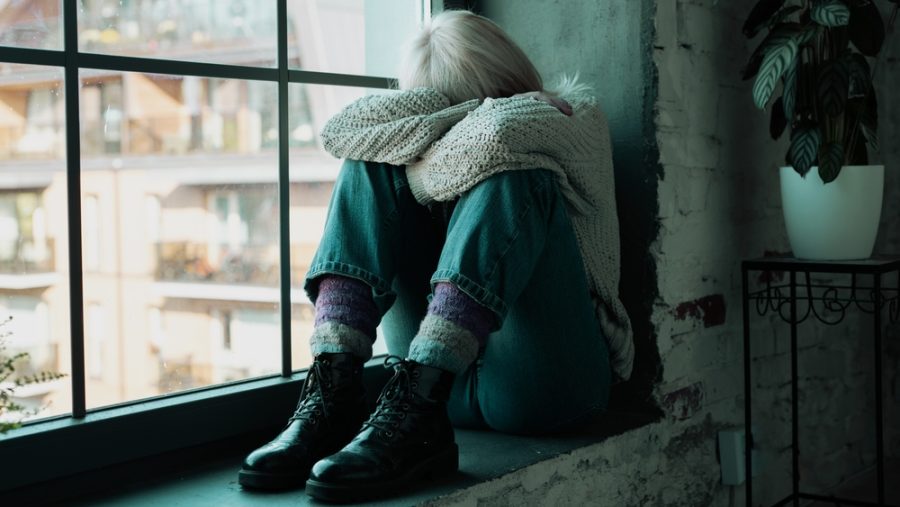Learning that a family member or friend is hurting themselves can be a startling discovery, and you might not know what to do next. Should you confront the situation? Should you get outside help? Are you overacting? Here are some common reasons people self-harm and a guide on how to help them.
If someone you know is self-harming, let us help. Contact Georgetown Behavioral Health to learn more.
What Does it Mean to Self-Harm?
Self-harm is most simply defined as when somebody intentionally damages or injures their body through various means. Yes, there are other types of destructive self-harm, including a wide variety of emotionally destructive behaviors; however, the most common type of self-harm recognized by parents, teachers, and the medical community is physical self-harm. In general, self-harming behaviors are used to cope with or express emotional stress that the person cannot manage in any other way.
Most individuals who self-harm do so to express distress, punish themselves, or relieve anxiety and tension that have become unbearable. Sometimes the reasons for self-harm are a combination of all the above. However, make no mistake, self-harm is often a cry for help. Unfortunately, it can also be hard to notice. Below we will explore a little further some of the reasons behind self-harming behaviors, what to watch for, and how to get help if you are concerned about a friend or loved one.
What May Cause Someone to Self-Harm?
Often when people think of the “type” of person who may self-harm, they think of individuals with a mental health condition or young adults faced with growing life stressors. Unfortunately, self-harm is far more common in younger (adolescents and teens) people than most people realize. Although people of all ages may self-harm, studies suggest that between 10 and 25% of teens and young adults will engage in self-harming behaviors at some time.
Social problems
Many people today experience a consistent struggle to cope with extreme levels of stress. This stress can be present at school, at work, at home, and in personal and social relationships. Additionally, our current world is highly driven (and motivated) by social media.
Consequently, it has become quite toxic and damaging. It is easy to fall prey to the negativity and hostility that is ever present on social media and in society today. People who feel they do not have an alternate outlet to manage these stressors may turn to self-harm as a coping tool.
Trauma
Witnessing or directly experiencing a traumatic event can also lead to self-harm as an escape from the painful and overwhelming emotions that often accompany trauma. Traumatic experiences can include various forms of abuse (physical, sexual, or emotional) or the death of a close family member or friend.
Mental health symptoms
Some people experience mental health issues resulting in their hearing voices or powerful thoughts telling them to do things. Sometimes, these thoughts or voices tell the person to self-harm. This can result from mental illnesses such as borderline personality disorder or other forms of dissociative disorders. Self-harming behaviors can also result from diagnoses related to depression and anxiety.
What are the Different Types of Self-Harm?
There are several different ways people can intentionally harm or injure themselves.
Cutting or Burning Their Skin
Cutting and burning are two of the most common forms of self-harm. Cutting is precisely what it sounds like; using a sharp object such as a knife, razor blade, or scissors to make cuts, marks, or scratches on one’s own body. Cutting, as with other self-harm activities, is an attempt to interrupt the feelings associated with strong emotions and pressures the individual feels they can no longer tolerate. The sensation of pain associated with cutting and burning behaviors releases endorphins that cause a “rush.” This endorphin rush provides a temporary escape from their current anxiety feelings.
Punching or Hitting Themselves
Similarly, the pain often associated with hitting or punching causes the endorphin release that provides a distraction. While generally not as dangerous (or potentially life-threatening) as cutting or other self-harming behaviors, these behaviors can still result in injury.
Other forms of self-harm include taking pills or liquids, resulting in illness or sickness. It is not uncommon for people who engage in self-harm to try to hide their bruises out of shame or fear of having their behavior discovered by others. They will often wear long sleeve shirts or long pants to hide cuts and bruises.
What are Possible Signs of Self-Harm?
As previously noted, those who engage in self-harming behaviors will often try to hide their behavior. As a result, their injuries will often go unnoticed for quite some time, putting them at a greater risk for
long-term injury or even loss of their life. Below are some signs you can look for if you are concerned that a friend or loved one is hurting themselves.
- Cuts, bruises, or burns that appear without explanation. These will generally be most prevalent on the arms, wrists, thighs, or chest; however, they can also appear elsewhere.
- If your child or teen keeps themselves fully covered despite warm or hot weather.
- Watch for signs of depression such as moodiness, lack of motivation, and reduced interest in their typical day-to-day activities.
- Self-loathing or a desire for self-punishment.
- Statements (or actions) about not wanting to “go on” or wanting to “end it all.”
- Becoming abnormally withdrawn and not speaking to others
- Outward signs of other forms of self-harm, such as unexplained bruises, missing hair, or missing fingernails.
What to do If Someone is Self-Harming?

Self-harming behaviors may be difficult to notice because the outward signs are not always visible. Often it is a friend, loved one, parent, or teacher who sees it first. Below are a few things you can do to help someone who is self-harming.
- Avoid judgment: Those who are self-harming may worry that they are being judged or that their friends and loved ones believe they are suicidal. This can cause them to shut down and withdraw even further.
- Seek understanding: Genuinely be interested in understanding how self-harming behavior helps them. This may help you understand why they do it. It might be helpful to know about the type of harming behavior frequency, coexisting mental health issues, willingness to seek help, and risk for suicide.
- Be supportive: Even if their actions don’t make sense to you, try to be supportive and tell them you will be there for them.
- Don’t dismiss: Please don’t dismiss or ridicule their actions.
- Don’t ask for promises: Asking someone to promise you they will stop hurting themselves may cause more distress by making them feel like they no longer have control over the action. Unfortunately, if they hurt themselves, they will feel additional guilt and worry about disappointing you.
- Try to be accepting and normalize: Acknowledge how they feel and cope is different. Gently encourage them to seek help to learn how to cope in safer ways. It may be helpful to gently help them understand that self-harming behavior is not helping or working while offering to assist with finding help.
Reach Out to a Professional for Support and Guidance
There isn’t one “core” treatment or “best treatment” for self-harming behavior. Individualized treatment plans are designed around the specific issues and the underlying mental health conditions that could lead to the behavior. For example, suppose the self-harming behavior is related to a mental health condition such as depression. In that case, a treatment plan will address the mental health condition and the resulting self-harming behavior.
If you or a loved one needs help coping, Georgetown Behavioral Hospital offers support and help for self-harming behaviors. Learning about triggers, what self-harm looks like, and treatment options can help you know what to do when someone is self-harming.
Contact Georgetown Behavioral Health to learn more about helping a loved one.















